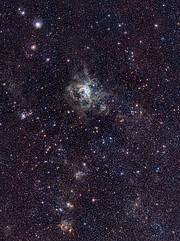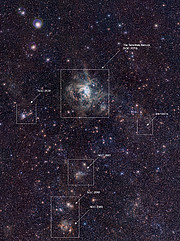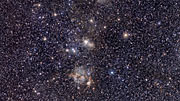Comunicato Stampa
Una amibziosa campagna di osservazione illumina un vivaio stellari
11 Agosto 2010

Gli astronomi scansionando i cieli nell’ambito dell’attività di osservazione con il telescopio VISTA della Nube di Magellano hanno ottenuto un'immagine spettacolare della Nebulosa Tarantola, sita nella nostra galassia limitrofa, la Grande Nube di Magellano. Questa visione panoramica ottenuta nel vicino infrarosso ha catturato sia la nebulosa stessa, con un dettaglio molto particolareggiato, ché la ricca area circostante del cielo. L'immagine è stata ottenuta all'inizio di un lavoro molto ambizioso di osservazione delle nostre vicine galassie, le Nubi di Magellano e i loro dintorni.
Maria Rosa-Cioni (Università di Hertfordshire, Regno Unito), a capo del gruppo di ricerca, spiega: "E’ l’immagine di una delle più importanti regioni di formazione stellare nell'Universo locale - la spettacolare regione di formazione stellare 30 Doradus, chiamata anche Nebulosa della Tarantola. Al centro vi è un grande ammasso di stelle chiamato RMC 136, nel quale si trovano alcune delle stelle più massicce ad oggi conosciute".
Il telescopio VISTA dell'ESO [1] è un nuovo telescopio di osservazione sito all'osservatorio di Paranal in Cile, (eso0949). VISTA è dotato di una grande fotocamera che opera nello spettro del vicino infrarosso, permettendo una ricchezza di dettaglio degli oggetti astronomici che ci permette di comprendere il funzionamento interno dei fenomeni astronomici stessi. Il vicino infrarosso ha una lunghezza d'onda più lunga della luce visibile e per questo è possibile vedere attraverso gran parte della polvere che normalmente oscura la nostra visione. Ciò lo rende particolarmente utile per lo studio di oggetti come le stelle giovani, ancora avvolte nel gas e nella polvere da cui si sono formate. Un altro aspetto significativo della capacità di Vista è dato dalla grande area di cielo che la sua fotocamera è in grado di catturare ad ogni scatto.
Questa immagine è l'ultima nell’ambito della campagna di osservazione VMC (VISTA Magellanic Cloud Survey). Il progetto prevede la scansione di una vasta area - 184 gradi quadrati di cielo (corrispondente a quasi un migliaio di volte la superficie apparente della Luna piena), comprensiva delle nostre vicine galassie, la Grande e la Piccola Nube di Magellano. Il risultato finale sarà uno studio dettagliato della storia delle stelle in formazione e una geometria tridimensionale del sistema di Magellano.
Chris Evans del team VMC aggiunge: "Le immagini ottenute con VISTA ci consentiranno di estendere i nostri studi oltre le regioni interne della Tarantola, in quella moltitudine di vicini vivai stellari più piccoli, caratterizzati da una ricca popolazione di stelle giovani e massicce. Così armati, di dettagliate immagini agli infrarossi, non solo saremo in grado di analizzare i bozzoli in cui stelle massicce sono ancora in formazione, ma anche di guardare la loro interazione con le stelle più vecchie del resto della regione."
L'immagine a grande campo mostra una moltitudine di oggetti differenti. L'area luminosa sopra il centro è la Nebulosa Tarantola stessa, con l’agglomerato di stelle massicce 136 RMC nel suo nucleo. A sinistra si trova l'ammasso stellare NGC 2100. A destra il tenue resto della supernova SN1987A (eso1032). Sotto al centro una serie di regioni di formazione stellare incluse NGC 2080 - denominato la "Nebulosa Testa di fantasma" - e l’ammasso stellare NGC 2083.
IL VMC (VISTA Magellanic Cloud Survey) è il primo di sei grandi progetti di osservazione nell’emisfero meridionale nel vicino infrarosso previsti per i primi cinque anni di attività di VISTA.
Note
[1] VISTA – il Telescopio per Astronomia per Osservazioni nel Visibile e nel Vicino Infrarosso – è il più recente telescopio installato all’Osservatorio dell’ESO di Paranal, nel nord del Cile. VISTA opera nella lunghezza d’onda del vicino infrarosso ed è il più grande telescopio al mondo per questo genere di osservazioni. Il suo largo specchio, a grande campo e con sensori molto sensibili ci permetterà di avere una completamente nuova visione del cielo meridionale.
Il Telescopio è collocato sul picco adiacente quello dove si trova il VLT (Very Large Telescope) dell’ESO e condivide con esso le stesse straordinarie condizioni di osservazione. VISTA ha lo specchio principale di 4.1 metri di diametro. In termini fotografici è come fosse una camera digitale a 67 megapixel con lenti di 13.000 mm f/3.25.
Ulteriori Informazioni
L’ESO (European Southern Observatory) è la principale organizzazione intergovernativa di Astronomia in Europa e l’osservatorio astronomico più produttivo al mondo. È sostenuto da 14 paesi: Austria, Belgio, Repubblica Ceca, Danimarca, Finlandia, Francia, Germania, Italia, Olanda, Portogallo, Spagna, Svezia, Svizzera e Gran Bretagna. L’ESO mette in atto un ambizioso programma che si concentra sulla progettazione, costruzione e gestione di potenti strutture astronomiche da terra che consentano agli astronomi di fare importanti scoperte scientifiche. L’ESO ha anche un ruolo preminente nel promuovere e organizzare cooperazione nella ricerca astronomica. L’ESO gestisce tre siti unici di livello mondiale in Cile: La Silla, Paranal e Chajnantor. A Paranal, l’ESO gestisce il Very Large Telescope, l’osservatorio astronomico nella banda visibile più d’avanguardia al mondo. L’ESO è il partner europeo di un telescopio astronomico rivoluzionario, ALMA, il più grande progetto astronomico esistente. L’ESO sta pianificando al momento la realizzazione di un gigantesco telescopio nell’ottico/vicino-infrarosso di 42 metri di diametro, lo European Extremely Large Telescope, E-ELT, che diventerà “il più grande occhio del mondo rivolto al cielo”.
Links
Contatti
Maria-Rosa Cioni
University of Hertfordshire
UK
Tel.: +44 1707 28 5189
E-mail: M.Cioni@herts.ac.uk
Richard Hook
ESO La Silla/Paranal & E-ELT Public Information Officer
Garching, Germany
Tel.: +49 89 3200 6655
E-mail: rhook@eso.org
Anna Wolter (press contact Italia)
Rete di divulgazione scientifica dell'ESO
e INAF-Osservatorio Astronomico di Brera
Milano, Italy
Tel.: +39 02 72320321
E-mail: eson-italy@eso.org
Sul Comunicato Stampa
| Comunicato Stampa N": | eso1033it |
| Nome: | 30 Doradus, Large Magellanic Cloud, LMC, Tarantula Nebula |
| Tipo: | Local Universe : Nebula |
| Facility: | Visible and Infrared Survey Telescope for Astronomy |
| Instruments: | VIRCAM |
Our use of Cookies
We use cookies that are essential for accessing our websites and using our services. We also use cookies to analyse, measure and improve our websites’ performance, to enable content sharing via social media and to display media content hosted on third-party platforms.
ESO Cookies Policy
The European Organisation for Astronomical Research in the Southern Hemisphere (ESO) is the pre-eminent intergovernmental science and technology organisation in astronomy. It carries out an ambitious programme focused on the design, construction and operation of powerful ground-based observing facilities for astronomy.
This Cookies Policy is intended to provide clarity by outlining the cookies used on the ESO public websites, their functions, the options you have for controlling them, and the ways you can contact us for additional details.
What are cookies?
Cookies are small pieces of data stored on your device by websites you visit. They serve various purposes, such as remembering login credentials and preferences and enhance your browsing experience.
Categories of cookies we use
Essential cookies (always active): These cookies are strictly necessary for the proper functioning of our website. Without these cookies, the website cannot operate correctly, and certain services, such as logging in or accessing secure areas, may not be available; because they are essential for the website’s operation, they cannot be disabled.
Functional Cookies: These cookies enhance your browsing experience by enabling additional features and personalization, such as remembering your preferences and settings. While not strictly necessary for the website to function, they improve usability and convenience; these cookies are only placed if you provide your consent.
Analytics cookies: These cookies collect information about how visitors interact with our website, such as which pages are visited most often and how users navigate the site. This data helps us improve website performance, optimize content, and enhance the user experience; these cookies are only placed if you provide your consent. We use the following analytics cookies.
Matomo Cookies:
This website uses Matomo (formerly Piwik), an open source software which enables the statistical analysis of website visits. Matomo uses cookies (text files) which are saved on your computer and which allow us to analyze how you use our website. The website user information generated by the cookies will only be saved on the servers of our IT Department. We use this information to analyze www.eso.org visits and to prepare reports on website activities. These data will not be disclosed to third parties.
On behalf of ESO, Matomo will use this information for the purpose of evaluating your use of the website, compiling reports on website activity and providing other services relating to website activity and internet usage.
Matomo cookies settings:
Additional Third-party cookies on ESO websites: some of our pages display content from external providers, e.g. YouTube.
Such third-party services are outside of ESO control and may, at any time, change their terms of service, use of cookies, etc.
YouTube: Some videos on the ESO website are embedded from ESO’s official YouTube channel. We have enabled YouTube’s privacy-enhanced mode, meaning that no cookies are set unless the user actively clicks on the video to play it. Additionally, in this mode, YouTube does not store any personally identifiable cookie data for embedded video playbacks. For more details, please refer to YouTube’s embedding videos information page.
Cookies can also be classified based on the following elements.
Regarding the domain, there are:
- First-party cookies, set by the website you are currently visiting. They are stored by the same domain that you are browsing and are used to enhance your experience on that site;
- Third-party cookies, set by a domain other than the one you are currently visiting.
As for their duration, cookies can be:
- Browser-session cookies, which are deleted when the user closes the browser;
- Stored cookies, which stay on the user's device for a predetermined period of time.
How to manage cookies
Cookie settings: You can modify your cookie choices for the ESO webpages at any time by clicking on the link Cookie settings at the bottom of any page.
In your browser: If you wish to delete cookies or instruct your browser to delete or block cookies by default, please visit the help pages of your browser:
Please be aware that if you delete or decline cookies, certain functionalities of our website may be not be available and your browsing experience may be affected.
You can set most browsers to prevent any cookies being placed on your device, but you may then have to manually adjust some preferences every time you visit a site/page. And some services and functionalities may not work properly at all (e.g. profile logging-in, shop check out).
Updates to the ESO Cookies Policy
The ESO Cookies Policy may be subject to future updates, which will be made available on this page.
Additional information
For any queries related to cookies, please contact: pdprATesoDOTorg.
As ESO public webpages are managed by our Department of Communication, your questions will be dealt with the support of the said Department.






